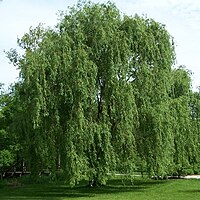
Photo from wikipedia
BACKGROUND Understanding the factors that promote the success of invasive species is important for managing biological invasions. Interactions between invasives and other species (e.g., competitors, pathogens, or predators), could favor… Click to show full abstract
BACKGROUND Understanding the factors that promote the success of invasive species is important for managing biological invasions. Interactions between invasives and other species (e.g., competitors, pathogens, or predators), could favor or limit their success. In recent decades, yellowjacket wasps, including Vespula germanica and V. vulgaris, have successfully established in Patagonia. Additionally, the invasive willow Salix fragilis has invaded areas next to watercourses, which in turn are typically colonized by the giant willow aphid (GWA, Tuberolagnus salignus), an additional species characterized as a successful invader in many regions worldwide. Aphid exudate (honeydew) has been reported to be used as a carbohydrate source by social wasps. The aim of our study was to gain a better understanding of the infestation pattern of the GWA in northwestern Patagonia, its effect on exudate availability and its relationship with yellowjacket foraging patterns. The study was conducted under the working hypothesis that the increase in the size of GWA colonies and resulting honeydew production, will fuel an increase in local Vespula spp. POPULATIONS RESULTS We found that the aphid honeydew is produced in relatively high amounts in the region (estimated at 1517 ± 139 Kg/ha/season), with strong indications that it is used by yellowjackets because of the significantly higher abundance levels of yellowjackets foraging on honeydew. CONCLUSION The interaction of three invasive species, willows, GWA and yellowjackets, needs to receive special attention to develop future environmentally-sound mitigation tools of these nuisance pest.
Journal Title: Pest management science
Year Published: 2023
Link to full text (if available)
Share on Social Media: Sign Up to like & get
recommendations!